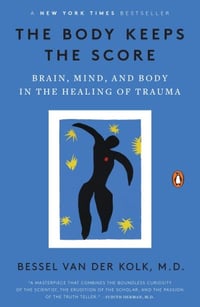NYC Therapist Heather Coleman gives her review on the book Body Keeps the Score and writes how important it is to understand trauma, its impact on our lives and ways to heal.
You Can Find Safety Again
When i finally get to work in the morning, 9 times out of 10 it dawns on me that I have no idea how I got there! Of course, I know I walked to the train and swiped my Metro Card and sat with fellow New Yorkers along the way, but I just didn’t feel it in my body. How many times does this happen to you? Our thoughts and our actions just don’t meet up; we think one way and our body moves in another direction.
This might happen when we’ve eaten a giant bag of potato chips and then think later: “what did I eat exactly?” Or we behaved in a certain way last night with our friends that we remember in the morning with remorse or regret. Quite literally this occurs because we are detached from our bodies, spaced out, dissociated you might say– this can happen in a variety of different ways and levels. Dissociation is a key element to the trauma response and is the number one reason that trauma survivors cannot take in new information and live in the present moment.
What is Complex Trauma and How It Affects The Brain
Trauma Changes The Brain On A Fundamental Level.
I’ve been lucky enough to be in the middle of a trauma intensive course with Dr. Bessel Van Der Kolk over the next few weeks and i’m learning amazing information about the functioning of the traumatized brain and how it impacts daily life. In his book, The Body Keeps the Score, he outlines a key element in brain changes with traumatic experience: “What is your brain doing when you have nothing in particular on your mind? It turns out that you pay attention to yourself: The default state activates the brain areas that work together to create your sense of ‘self.’” He goes on to explain that midline structures of the brain, responsible for self-awareness, are heavily activated in normal brains; moreover, the back of the brain, the posterior cingulate, is like the body’s internal GPS system that can tell us where we are in physical space.
Author and leading trauma expert, Van Der Kolk states how this is connected to brain regions that register sensations and emotions (the insula and anterior cingulate); and all of these areas working together form consciousness. So what he found was startling: In brains with PTSD, these areas were deadened and the only area slightly activated was one responsible for orientation to space. This means that when the trauma happened, the brain shut these areas down to deal with the event and to moderate the fear and stress incurred, but at the same time it also means that it dulled the areas meant for feeling sensation and the foundation for self-awareness to tell us who (and sometimes where) we are. In other words, he interpreted the results to mean that someone has lost the capacity to feel fully alive.
What Are The Signs Of Complex Trauma And Is There A Trauma Treatment?

As a psychotherapist in New York City, I see a lot of clients with vague or well-defined trauma. Most of the time, this trauma is shrouded in shame, guilt and negative self-talk. They might present with a confused sense of self and purpose, as well as feeling isolated and disconnected from family and peers. If we are unable to inhabit and live safely in our body, then no wonder we feel directionless and mistrusting of others–we’ve lost our internal GPS so to speak! On the other hand, thank goodness the brain and body did do the person a service by shutting down to deaden the pain and intensity of a traumatic situation; however, after that point, the system continues to respond in that way when it might not be needed (in non-threatening situations for instance). Humans are complicated and interesting; with unconscious genius, we manage to form “creative adjustments” (a Gestalt therapy term) to deal with our pain. We drive our car fast and recklessly to mimic mobilization when we were formerly faced with immobilizing fright. We take extreme amounts of drugs and alcohol to numb out a bodily sensation that may be repeating itself to try to get the attention that it deserves and needs. We might dissociate and inadvertently turn away from friends because the body and mind specifically want to self-preserve and deaden all relationships as an insurance policy for further hurt and pain.
3 Ways To Calm Your Brain, Mind And Body
It seems like a massive undertaking to heal after trauma, but it doesn’t have to be. It’s completely workable and takes time, effort and a supportive ear. The following is part of a plan I garnered from my understanding of Bessel Van Der Kolk’s work and other trauma experts such as Peter Levine– of course it is best to do this work with an experienced therapist who has a familiarity with trauma and how it’s stored in the body.
1. We Have To Clean House And Make Renovations
A sense of safety is the first thing that gets lost with trauma. Obviously, with some traumas, there was a real lack of personal and physical safety. In other less obvious developmental trauma, such as with neglect, a person’s sense of safety is shattered from not having someone to securely and consistently rely upon for a safe environment and soothing nervous system regulation. Over time, the body becomes less of a safe place to inhabit because of the intense emotions and pain one would have to feel being stuck reliving trauma– so we freeze and then get evicted from our “homebody” so to speak! It all starts here.
There will be very little movement forward if we are unable to gain the resource of feeling safe in our body, both concretely and even fantastically (being able to imagine safety, safe people, safe experiences, safe places). I like to think of this as doing Bob Vila, “This Old House” kind of work. Let’s imagine that your body is an old Victorian home that needs a partial remodel– it’s really beautiful, has funky history and unique detailing, but the floorboards are creaky, the paint is peeling, the foundation is a bit wobbly and it just doesn’t feel like a safe place to live in yet! So in comes you (or Bob Vila!) to do a full make-over and remodel; not because the house is bad or dirty, but rather because the house needs to feel like a solid structure again– that you’re not going to put your foot through the floor in the bedroom down to the kitchen ceiling! The body needs to be your home again–completely your own with chosen details by you so it can feel like a solid, secure and warm place to live again.
2. We Have To Have Our Adult Selves Heal And Become Friends With The Wounded Child
I’m learning in the Bessel Van Der Kolk trauma course that healing comes from an exchange granted between our adult selves and our child selves–one that is warm, nurturing and attentive. Working with people these past few years, I’ve noticed that we have both adult and child parts at play in our present lives (ex. adult parts make adult decisions, can self-soothe, can protect, while child parts are creative and playful but can also be frightened, powerless, and confused by adult tasks). In order to heal trauma, the adult part needs to converse with and give to the child part. Our current adult, strong, resourced, self needs to make room for the wounded child and imagine offering him/her everything that they never received–(ie protection, safety, attention, nurturing, care). This discourse between these parts in the ground for allowing them to co-exist while not allowing the child to run the show; after all, that’s too much pressure for the child anyway.
3. We Have To Find Ways To Re-Regulate A Dysregulated Nervous System
Trauma gets passed down intergenerationally. Wherever we find trauma, most likely we will find a history of trauma in the family. If our parents’ nervous system was set to an activated state most of the time–meaning they were too frightened to take control and be parents or too angry while consistently flying off the handle–most likely we inherited a nervous system that is also dysregulated as a result of being raised by someone who didn’t have the skill to self-regulate. As a result, our nervous system might be tuned to high (activation) or has shut down completely (is frozen)–and we remain fairly stuck in these states.
The Body Keeps The Score And Neurofeedback Training
The good news is that there are many ways to re-regulate your nervous system and bring it out of that state—allowing it to be more flexible, present, and open. Many clients report that meditation, yoga, acupuncture, even being with animals/pets can help bring them into regulated states. A specific and gentle way of re-regulating the nervous system is with neurofeedback. Van Der Kolk speaks about how neurofeedback can help with trauma in The Body Keeps the Score:
“Patients need help to change the habitual brain patterns created by trauma and its aftermath. When the fear patterns relax, the brain becomes less susceptible to automatic stress reactions and better able to focus on ordinary events. After all, stress is not an inherent property of events themselves–it is a function of how we label and react to them. Neurofeedback simply stabilizes the brain to increase resiliency, allowing us to develop more choices in how to respond.”
There are many ways to self-regulate, but I commonly use neurofeedback with the *NeurOptimal® neurofeedback system in my practice to help someone’s nervous system find a new baseline level of functioning, especially to reach unconscious mechanisms at play that push the system into dysregulation.
Who Can Benefit From Neurofeedback?
Once the body is a newly safe place to live and come back home to, the possibilities are endless. Thoughts can change. Connections can be made. Purpose can be found. If we can live fully in our bodies, we have more of an opportunity to meet our experience–both internally and externally–in a full way. We literally feel as though we have come back to our senses. Learn more about neurofeedback training and how it works here.
How To Start With Neurofeedback Training
We offer in-office sessions at our NYC location and one can even use neurofeedback in combination with therapy which allows the most effective way to heal trauma. Another way is to rent a neurofeedback device, which is the most cost-effective alternative. The NeurOptimal home system offers the same training as in our clinics and is very easy to use. This training option will allow for the whole family or couple to train together at their own time and pace.
*NeurOptimal® is training, not a treatment. Consequently, NeurOptimal®does not require diagnosis or treatment planning. You should be under the care of a physician for any medical disorder.




